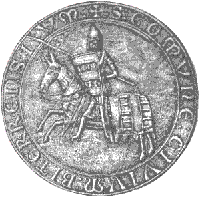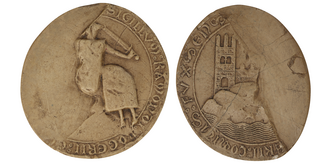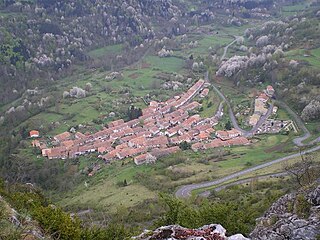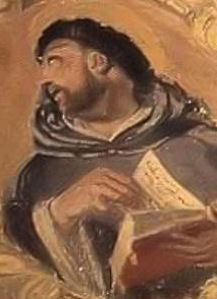Catharism was a Christian quasi-dualist or pseudo-Gnostic movement which thrived in Southern Europe, particularly in northern Italy and southern France, between the 12th and 14th centuries. Denounced as a heretical sect by the Catholic Church, its followers were attacked first by the Albigensian Crusade and later by the Medieval Inquisition, which eradicated the sect by 1350. Many thousands were slaughtered, hanged, or burnt at the stake, sometimes without regard for "age or sex."

The Albigensian Crusade or Cathar Crusade (1209–1229) was a military and ideological campaign initiated by Pope Innocent III to eliminate Catharism in Languedoc, what is now southern France. The Crusade was prosecuted primarily by the French crown and promptly took on a political aspect. It resulted in the significant reduction of practicing Cathars and a realignment of the County of Toulouse with the French crown. The distinct regional culture of Languedoc was also diminished.

The Château de Montségur is a former fortress near Montségur, a commune in the Ariège department in southern France. Its ruins are the site of a razed stronghold of the Cathars. The present fortress on the site, though described as one of the "Cathar castles," is actually of a later period. It has been listed as a monument historique by the French Ministry of Culture since 1862.

Raymond VI was Count of Toulouse and Marquis of Provence from 1194 to 1222. He was also Count of Melgueil from 1173 to 1190.

Raymond Roger Trencavel was a member of the noble Trencavel family. He was viscount of Béziers and Albi, and viscount of Carcassonne and the Razès.

Pierre de Castelnau, French ecclesiastic, made papal legate in 1199 to address the Cathar heresy, he was subsequently murdered in 1208. Following his death Pope Innocent III beatified him by papal order, excommunicated Count Raymond VI of Toulouse, and declared the Albigensian crusade.

Raimond Roger was the sixth Count of Foix from the House of Foix. He was the son and successor of Roger Bernard I and his wife Cécilia Trencavel.

Lavelanet is a commune in the Ariège department in the Occitanie region in southwestern France.

Arnaud Amalric was a Cistercian abbot who played a prominent role in the Albigensian Crusade. It is reported that prior to the massacre of Béziers, Amalric, when asked how to distinguish Cathars from Catholics, responded, "Kill them [all], for God knows which are His own."

Cathar castles are a group of medieval castles located in the Languedoc region. Some had a Cathar connection in that they offered refuge to dispossessed Cathars in the thirteenth century. Many of these sites were replaced by new castles built by the victorious French Crusaders and the term Cathar castle is also applied to these fortifications despite their having no connection with Cathars. The fate of many Cathar castles, at least for the early part of the Crusade, is outlined in the contemporary Occitan "Chanson de la Croisade", translated into English as the "Song of the Cathar Wars ".
Esclarmonde of Foix, was a prominent figure associated with Catharism in thirteenth century Occitania.
Raymond du Fauga was a French Dominican, and bishop of Toulouse from 1232 to 1270. He was a significant figure in the struggle in Languedoc between the Catholic Church and the Cathars.
The Black Brotherhood was an urban society established in Toulouse in 1211 in response to the White Brotherhood led by the bishop Folquet de Marselha. The Blacks opposed the Albigensian Crusade and supported the Count of Toulouse, Raymond VII.

Montségur is a commune in the Ariège department in southwestern France.
Guilhabert de Castres was a prominent Cathar theologian. Born in Castres, he became a Cathar Perfect and, between 1223 and 1226, Bishop of Toulouse in the Cathar Church. In the theological debates in the early 13th century between the Cathars and the Papal representatives, he presented the Cathar arguments, including at the Debate at Montreal in 1206 and at the last Debate at Pamiers where he encountered Saint Dominic in 1207, prior to the Albigensian Crusades.

The Massacre at Béziers occurred on 22 July 1209 during the sack of Béziers by crusaders. It was the first major military action of the Albigensian Crusade.

The siege of Montségur was a siege that took place during the Albigensian Crusade. It pitted the royal forces of Louis IX of France and those of the bishops of Albi and Narbonne against the forces of Pierre Roger de Mirepoix, who protected a community of Cathars in Montségur.
"Caedite eos. Novit enim Dominus qui sunt eius." is a phrase reportedly spoken by the commander of the Albigensian Crusade, prior to the massacre at Béziers on 22 July 1209. A direct translation of the Medieval Latin phrase is "Kill them. The Lord knows those that are his own". Papal legate and Cistercian abbot Arnaud Amalric was the military commander of the Crusade in its initial phase and leader of this first major military action of the Crusade, the assault on Béziers, and was reported by Caesarius of Heisterbach to have uttered the order.
Bernard de Caux, or in Latin Bernardo or Bernardus de Caucio, was a Dominican friar and medieval inquisitor. His activities mainly took place in the region of the County of Toulouse between 1243 and 1249. He originated the investigation processes and his witness interrogations are recorded in a 13th-century transcribed manuscript preserved in the library of Toulouse.

William Arnaud or Guillaume Arnaud was a Dominican inquisitor and martyr.














